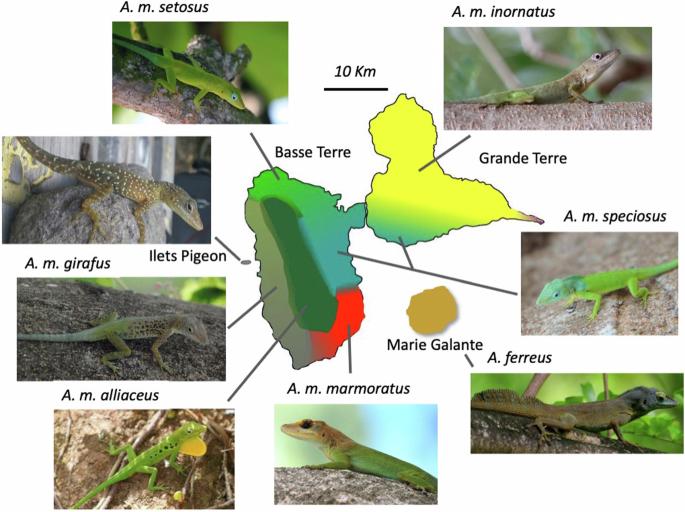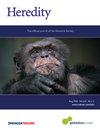Influence of geographic isolation and the environment on gene flow among phenotypically diverse lizards
IF 3.9
2区 生物学
Q2 ECOLOGY
引用次数: 0
Abstract
Lizards in the genus Anolis comprise hundreds of species that display a wide range of phenotypic variation closely related to their environment. One example is the Guadeloupean anole (Anolis marmoratus ssp.) that display extreme phenotypic variation, primarily in adult male color and pattern, with twelve described subspecies on the archipelago. Here we examine the relationship between phenotypic and genetic divergence among five subspecies on the two main islands and test the role of geographic isolation and the environment in reducing gene flow. We also examined two offshore island populations to assess the impact of complete geographic isolation on gene flow. We analyzed color phenotypes by measuring spectral reflectance and genomic diversity using SNPs. Genetic divergence was correlated with dorsolateral head and body color phenotypes, and slope and geographic distance were nearly equivalent at explaining this divergence. There was minimal genome-wide divergence at neutral loci among phenotypically disparate subspecies on the two main islands and their differentiation is consistent with a model of divergence with gene flow. Our spatial visualization of gene flow showed an impact of environmental features consistent with a hypothesis of ecologically driven divergence. Nonetheless, subspecies on the two main islands remain interconnected by substantial gene flow and their phenotypic variation is likely maintained at selection-gene flow equilibrium by divergent selection at loci associated with their color phenotypes. Greater isolation, such as inhabiting a remote island, may be required for reducing gene flow. Our findings highlight the role of the environment, adaptation, and geographic isolation on gene flow.


地理隔离和环境对不同表型蜥蜴间基因流动的影响
巨蜥属有数百种蜥蜴,它们的表型变异范围很广,与其生活环境密切相关。其中一个例子是瓜德罗普无尾熊(Anolis marmoratus ssp.),它表现出极端的表型变异,主要是成年雄性的颜色和花纹,在群岛上有 12 个已描述的亚种。在这里,我们研究了两个主要岛屿上五个亚种的表型和遗传分化之间的关系,并检验了地理隔离和环境在减少基因流动中的作用。我们还考察了两个离岸岛屿种群,以评估完全地理隔离对基因流动的影响。我们通过测量光谱反射率分析了颜色表型,并使用 SNPs 分析了基因组多样性。遗传差异与头背侧和身体颜色表型相关,斜率和地理距离在解释这种差异方面几乎相同。在两个主要岛屿上表型不同的亚种之间,中性位点上的全基因组差异极小,它们的分化符合基因流分化模型。我们对基因流的空间可视化显示了环境特征的影响,这与生态驱动分化的假设是一致的。尽管如此,两个主要岛屿上的亚种仍然通过大量的基因流相互连接,它们的表型变异很可能通过与颜色表型相关的位点上的分化选择而维持在选择-基因流平衡状态。要减少基因流,可能需要更大的隔离,如居住在偏远岛屿。我们的研究结果突显了环境、适应性和地理隔离对基因流的作用。
本文章由计算机程序翻译,如有差异,请以英文原文为准。
求助全文
约1分钟内获得全文
求助全文
来源期刊

Heredity
生物-进化生物学
CiteScore
7.50
自引率
2.60%
发文量
84
审稿时长
4-8 weeks
期刊介绍:
Heredity is the official journal of the Genetics Society. It covers a broad range of topics within the field of genetics and therefore papers must address conceptual or applied issues of interest to the journal''s wide readership
 求助内容:
求助内容: 应助结果提醒方式:
应助结果提醒方式:


